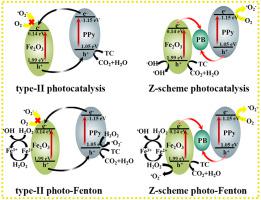Journal of Hazardous Materials ( IF 13.6 ) Pub Date : 2020-11-26 , DOI: 10.1016/j.jhazmat.2020.124668 Yang Yang , Shouchun Ma , Jiapeng Qu , Jiaqi Li , Yi Liu , Qianqian Wang , Jing Jing , Ye Yuan , Tongjie Yao , Jie Wu

|
Photo-Fenton reaction is a more effective technique for pollutant disposal than photocatalytic reaction. Herein, Fe2O3@polypyrrole/Prussian blue (Fe2O3@PPy/PB) with a hierarchical porous structure was prepared by a reactive-template method. After transforming typical type-II Fe2O3@PPy to Z-scheme Fe2O3@PPy/PB via PB as a bridge, the degradation rate was increased by 1.4 times in photocatalytic reaction and 4.0 times in photo-Fenton reaction due to higher visible-light harvest, enhanced separation efficiency of photoinduced charges, lower interface resistance, and especially well-preserved redox potentials of holes and electrons. Mechanism studies revealed that holes were quenched by H2O2, and this led to •O2− generation and efficient separation of electrons. Meanwhile, O2 was reduced by separated electrons, and this further increased •O2− yield. Therefore, the main radicals changed from hole in photocatalytic reaction to •O2− in the photo-Fenton reaction, leading to an increase as high as 12.1-fold enhancement in the degradation rate. Conversely, only H2O2 participated into photocatalytic reaction using Fe2O3@PPy while O2 was absent, resulting in merely 4.2-fold improvement. This manuscript gives a comprehensive understanding on mechanisms of type-II and Z-scheme heterojunctions in both photocatalytic and photo-Fenton reactions. Obviously, the outcomes are beneficial for designing catalysts with high photo-Fenton activity.
中文翻译:

转化II型的Fe 2 ö 3 @polypyrrole到Z-方案的Fe 2 ö 3在光Fenton反应和机理洞察的增强的活性:通过普鲁士蓝作为桥@聚吡咯/普鲁士蓝
光芬顿反应比光催化反应是一种更有效的污染物处理技术。在此,通过反应模板法制备具有分级的多孔结构的Fe 2 O 3聚吡咯/普鲁士蓝(Fe 2 O 3 PPy / PB)。在将典型的II型Fe 2 O 3 @PPy转化为Z型Fe 2 O 3之后@ PPy / PB通过PB作为桥,由于更高的可见光收率,增强的光诱导电荷分离效率,较低的界面电阻,光催化反应的降解速率提高了1.4倍,光芬顿反应的降解速率提高了4.0倍。空穴和电子的保存完好的氧化还原电位。机理研究表明,孔是由H淬火2 Ø 2,这导致• Ø 2 -生成和电子有效地分离。同时,O- 2通过分离的电子减少,这进一步增加• ö 2 -产量。因此,主要自由基从光催化反应中的空穴变为• ø 2 -在光Fenton反应,从而增加高达中的降解率12.1倍的增强。相反,仅Fe 2 O 3 @PPy参与H 2 O 2的光催化反应,而不存在O 2,仅提高4.2倍。该手稿对光催化和光芬顿反应中的II型和Z型异质结的机理提供了全面的了解。显然,结果对于设计具有高光芬顿活性的催化剂是有益的。



























 京公网安备 11010802027423号
京公网安备 11010802027423号